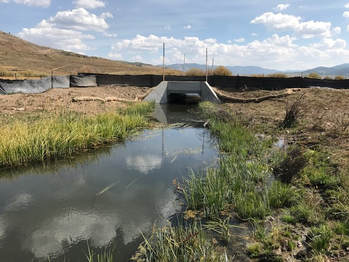Civil Engineering Projects

Angus Creek Fish Passage Project, Caribou County, Idaho
Biota worked for Trout Unlimited to engineer and design a project to improve fish passage for native Bonneville cutthroat trout through 2 county roadway crossings of Angus Creek in the Upper Blackfoot River drainage. Implementation of the project involved installation of fabricated concrete box culverts with live bottom stream conditions, and fluvial system site improvements that achieved fish passage objectives, protected public infrastructure and access.
Biota worked for Trout Unlimited to engineer and design a project to improve fish passage for native Bonneville cutthroat trout through 2 county roadway crossings of Angus Creek in the Upper Blackfoot River drainage. Implementation of the project involved installation of fabricated concrete box culverts with live bottom stream conditions, and fluvial system site improvements that achieved fish passage objectives, protected public infrastructure and access.

Snake River Geomorphic Assessment and Stabilization Project, Teton County, Wyoming
Biota was hired by the Teton County Road and Levee Department and the Teton County Engineering Department to design, permit, and implement solutions to severe lateral channel migration, bank erosion, and flooding along the Snake River south of Jackson, Wyoming. Geomorphic assessment and related analyses were used to develop a design that incorporated various instream structures to stabilize stream banks and protect private lands while addressing concerns of localized flooding and threats to public health, safety, welfare, and county road infrastructure. The effort achieved project objectives of bank stabilization and flood control along a reach of the flashy Snake River where peak flows have reached 30,000 cubic feet per second (cfs).

Badger Creek Project, Teton County, Idaho
Biota worked for the Teton County Idaho Engineering Department to design stabilization activities within and adjacent to Badger Creek to control flood waters, halt severe erosion, prevent loss of public infrastructure and private lands, and comply with regulatory requirements. Based upon hydrologic analysis, geomorphic assessment, and sediment transport modeling and hydraulic condition assessment, a stable channel morphology was designed and constructed through channel grading and incorporation of various hard and soft treatments. The project was implemented in 2012, and has functioned well to demonstrate that county infrastructure can benefit from appropriate fluvial system improvement efforts. The effort restored proper fluvial process, protected public infrastructure and safety, and rectified flood conditions that have destroyed Teton County roadways numerous times in the recent past.
Biota worked for the Teton County Idaho Engineering Department to design stabilization activities within and adjacent to Badger Creek to control flood waters, halt severe erosion, prevent loss of public infrastructure and private lands, and comply with regulatory requirements. Based upon hydrologic analysis, geomorphic assessment, and sediment transport modeling and hydraulic condition assessment, a stable channel morphology was designed and constructed through channel grading and incorporation of various hard and soft treatments. The project was implemented in 2012, and has functioned well to demonstrate that county infrastructure can benefit from appropriate fluvial system improvement efforts. The effort restored proper fluvial process, protected public infrastructure and safety, and rectified flood conditions that have destroyed Teton County roadways numerous times in the recent past.
Fish Creek Diversion and Site Improvement Project, Gros Ventre Basin, Teton County, Wyoming
The Fish Creek Project focused on maintaining the functionality of an irrigation diversion while stabilizing a rapidly eroding stream bank in order to protect infrastructure and public lands. Fish Creek has peak flows of several thousand cubic feet per second and is a tributary to the upper Gros Ventre River. This flashy freestone system was degraded during a century of continuous anthropogenic channel manipulations (push-up dam construction, channel dredging) associated with maintaining diversion function.
Based on a morphologic stream assessment and hydrologic analysis, engineered channel stabilization treatments were designed and installed using bank toe wood protection, large woody debris roughness structures, infrastructure improvements, and bioengineering treatments inclusive of log revetments, root wad revetments, stinger and pole plantings, clump transplants, willow trenches, and bank contouring.
The Fish Creek Project focused on maintaining the functionality of an irrigation diversion while stabilizing a rapidly eroding stream bank in order to protect infrastructure and public lands. Fish Creek has peak flows of several thousand cubic feet per second and is a tributary to the upper Gros Ventre River. This flashy freestone system was degraded during a century of continuous anthropogenic channel manipulations (push-up dam construction, channel dredging) associated with maintaining diversion function.
Based on a morphologic stream assessment and hydrologic analysis, engineered channel stabilization treatments were designed and installed using bank toe wood protection, large woody debris roughness structures, infrastructure improvements, and bioengineering treatments inclusive of log revetments, root wad revetments, stinger and pole plantings, clump transplants, willow trenches, and bank contouring.


